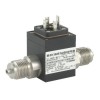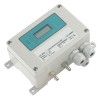Learn the method to convert a differential pressure (DP) sensor for absolute pressure measurement.
- Absolute pressure is measured relative to a perfect vacuum.
- A DP sensor can be used to measure absolute pressure by creating a vacuum on one side.
- The vacuum can be created using a pump or sealed with an isolation valve.
- The pressure to be measured is applied to the other side of the sensor.
- The sensor output represents the pressure difference, which is equal to the absolute pressure since the other side is under vacuum.
Featured differential pressure sensor products
 Low range ATEX approved 100 Pascal range DP transmitter - The DPT200 is a robust ATEX approved differential pressure transmitter which has a very low range of 100Pa.
Low range ATEX approved 100 Pascal range DP transmitter - The DPT200 is a robust ATEX approved differential pressure transmitter which has a very low range of 100Pa. DPS300 User Switchable Pressure Range, Volts or Current Output Low DP Sensor - The DPS 300 is a low range HVAC differential pressure sensor. The lowest possible pressure range is 0...100 pascals. 2 or 3 switchable pressure ranges, plus volts or current output are included with most standard configurations.
DPS300 User Switchable Pressure Range, Volts or Current Output Low DP Sensor - The DPS 300 is a low range HVAC differential pressure sensor. The lowest possible pressure range is 0...100 pascals. 2 or 3 switchable pressure ranges, plus volts or current output are included with most standard configurations.
Absolute pressure is the measurement of pressure relative to a perfect vacuum, or true zero pressure. This is normally achieved by using a sensor that has a vacuum trapped on the reverse side of the sensing diaphragm.
A differential pressure sensor is designed for pressure to be applied to both sides, and the mechanical design and fittings are designed to be used over a wide range of pressures including the vacuum range. It is therefore possible to apply full vacuum to the negative side of the dp sensor, to create an absolute reference.
The vacuum on the negative side can be created by connecting a vacuum source from a pump to continuously maintain an absolute reference during operation, or a vacuum can be applied and then sealed off using a suitable isolation valve able to provide a leak tight vacuum seal.
When pressure is now applied to the positive side connection of the dp sensor, it will be measured relative to full vacuum, providing an output signal which in exactly the same way as a conventional absolute reference pressure sensor.
Featured differential pressure sensor products
 Low delta P sensor with 200mmH2O range and response time < 5ms - The DMD331 uses silicon technology which is very small compared to other sensing technologies which would have a more limited response time.
Low delta P sensor with 200mmH2O range and response time < 5ms - The DMD331 uses silicon technology which is very small compared to other sensing technologies which would have a more limited response time. DPS Low Differential Pressure Transmitter - Ultra low differential pressure transmitter for HVAC applications with 4-20mA current loop or amplified voltage output signal in pressure ranges from 0.1 mb up to 1 bar differential.
DPS Low Differential Pressure Transmitter - Ultra low differential pressure transmitter for HVAC applications with 4-20mA current loop or amplified voltage output signal in pressure ranges from 0.1 mb up to 1 bar differential.
Here are the steps to measure absolute pressure with a DP sensor:
- Choose a suitable DP sensor: Select a DP sensor with a measurement range that covers the expected absolute pressure values. Ensure the sensor can handle vacuum on either side.
- Create a vacuum reference:
- Option 1: Continuous pumping: Connect the negative side of the DP sensor to a vacuum pump and maintain the vacuum throughout the measurement.
- Option 2: Sealed vacuum: Apply a vacuum to the negative side using a pump and then seal it off with a leak-tight isolation valve.
- Connect the pressure source: Apply the pressure to be measured to the positive side of the DP sensor.
- Read the sensor output: The DP sensor will output a value representing the pressure difference between the positive and negative sides. Since the negative side is under vacuum (zero pressure), the output directly represents the absolute pressure applied.
Related Help Guides
- Measuring vacuum with negative gauge or absolute ranges
- What is the difference between gauge and absolute pressure measurement
- What is the difference between vacuum and absolute pressure
- Measuring negative pressure using a positive differential pressure range
- Measuring liquid level in a sealed tank with a hydrostatic pressure sensor
- Measuring the difference in air pressure between rooms
- Measuring vacuum as a negative gauge pressure using a dp sensor
- Measuring liquid level in a tank using a dp sensor
- Measuring density of a liquid using a dp sensor
Related Technical Terms
Related Online Tools
- DP Flow Transmitter Output Calculator
- High and Low Side Pressure to Differential Pressure Calculator
- Gauge + Barometric to Absolute Pressure Calculator
Related Product and Application Guides
Related Application Questions and Answers
- Air Replacement Plant (ARP) 100 mm H2O differential pressure transmitter
- Ex rated ambient pressure sensor with 800-1100 mbar range
- 20 bar absolute steam pressure transducer
- Vacuum drying pressure data logger
- 180 degC pressure sensor for saturated steam up to 10 bar
- 1013 to 1400 mbar barometric pressure transmitter & readout
- Using 25 mbar DP sensor on vacuum below 0.2 bar absolute
- Measuring steam pressure up to 10bar with analog/digital output
- Low range ATEX approved 100 Pascal range DP transmitter
- Wind turbine USB PC logging pressure & temperature sensor
- Hydrophone array submersible 200 meter seawater depth sensor
- Biogas HDPE cover PD blower pressure sensor
Contact us about this Measuring absolute pressure using a dp sensor page to request more information, or to discuss your application requirements.


